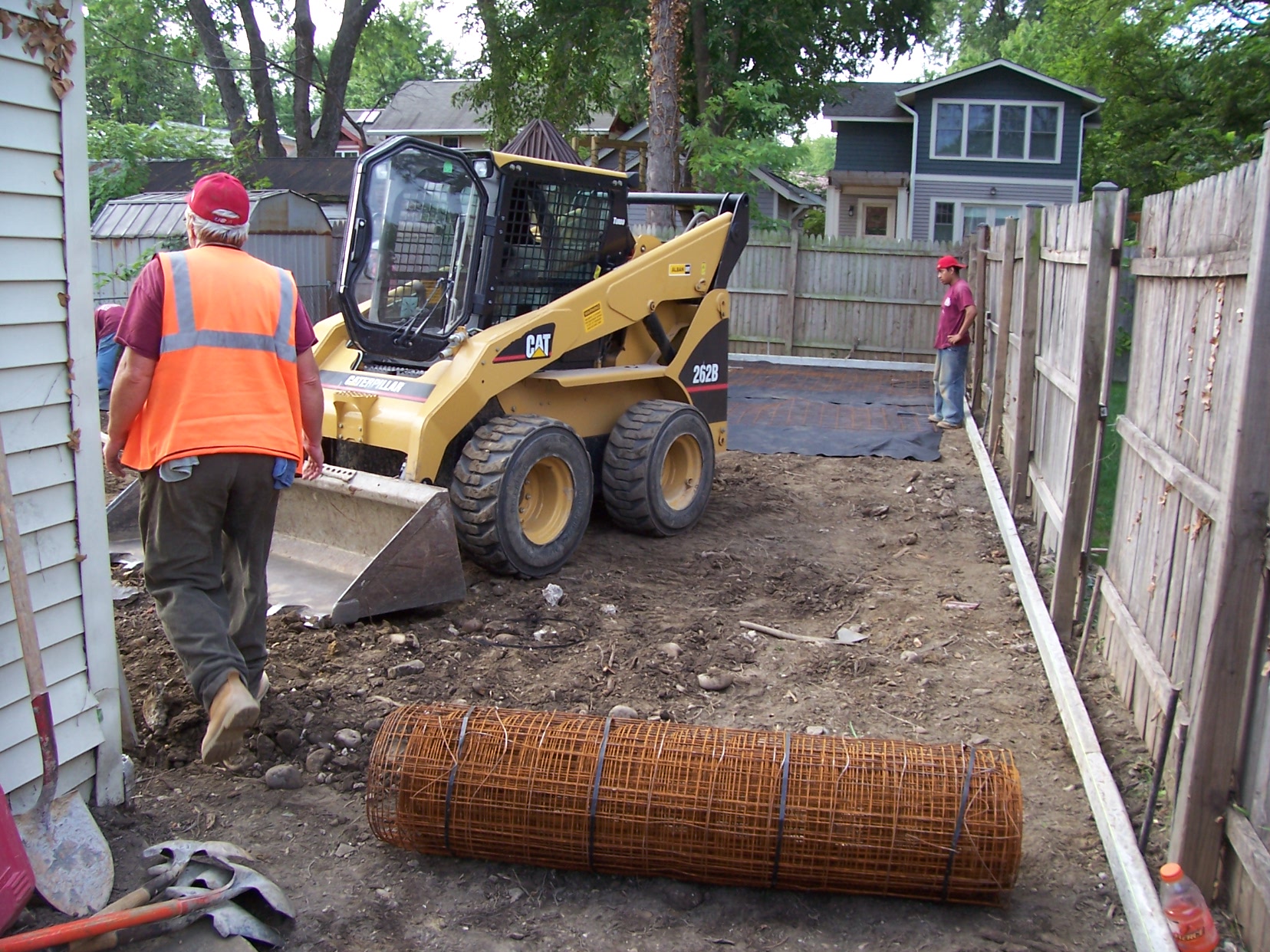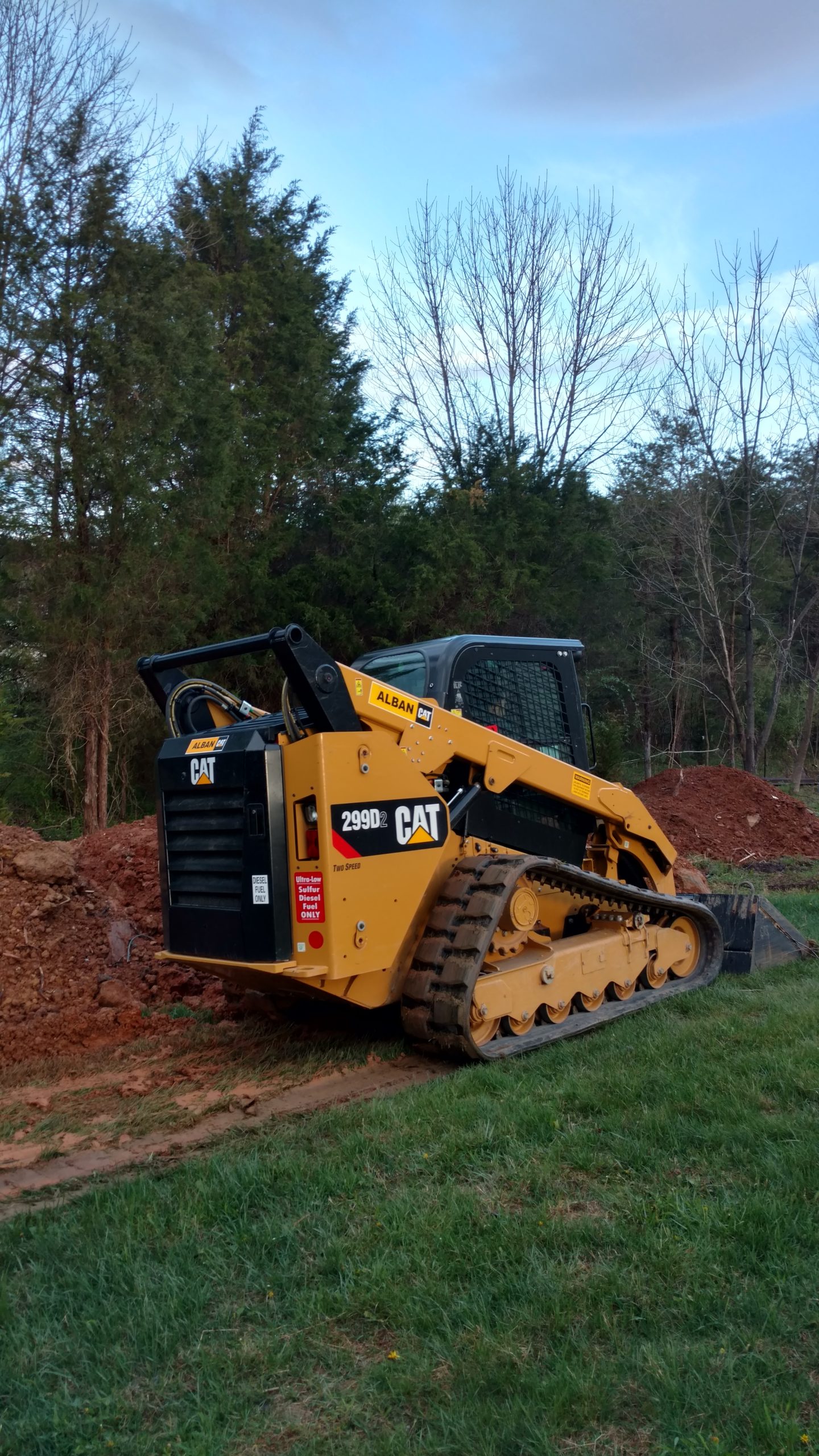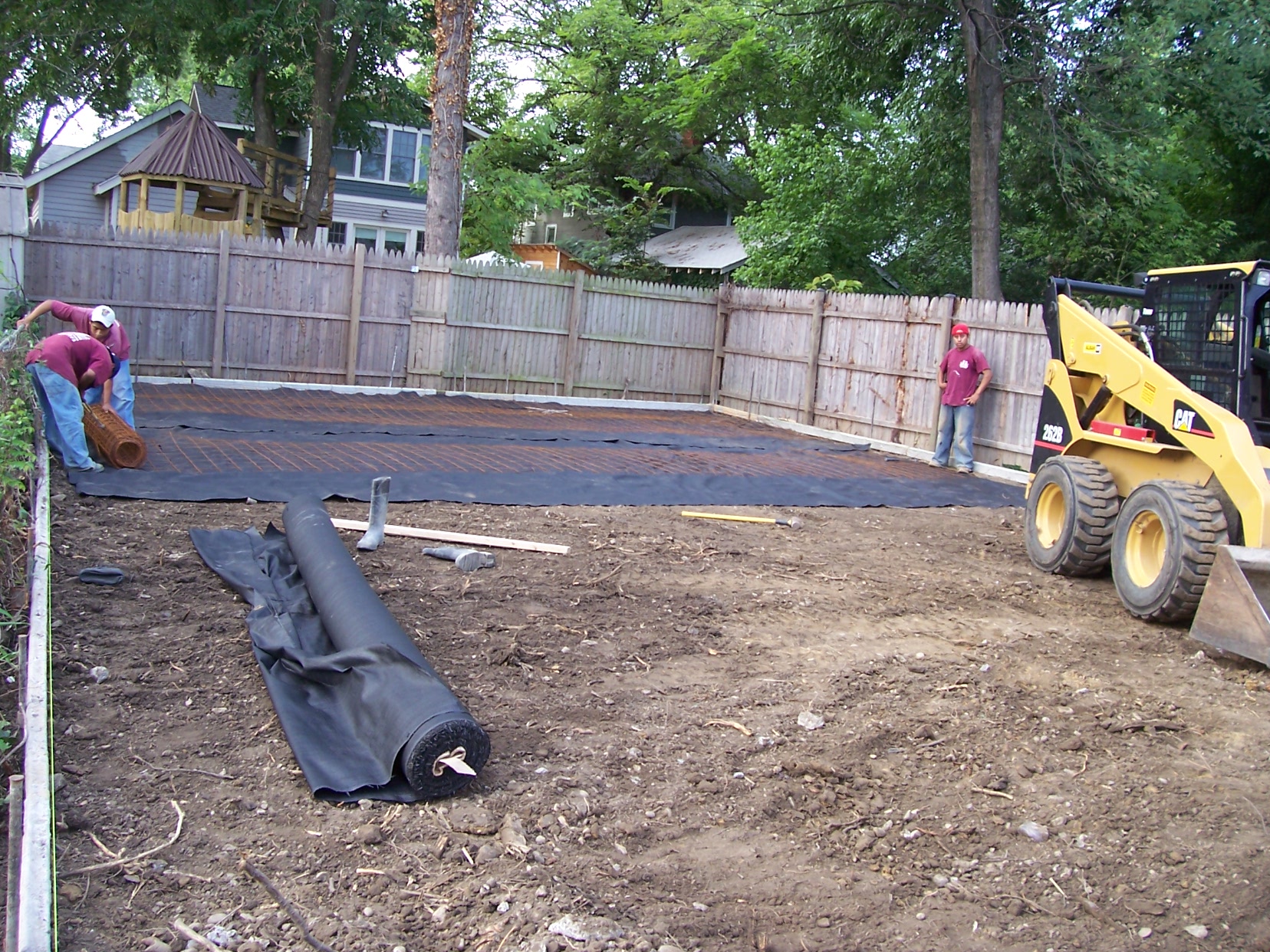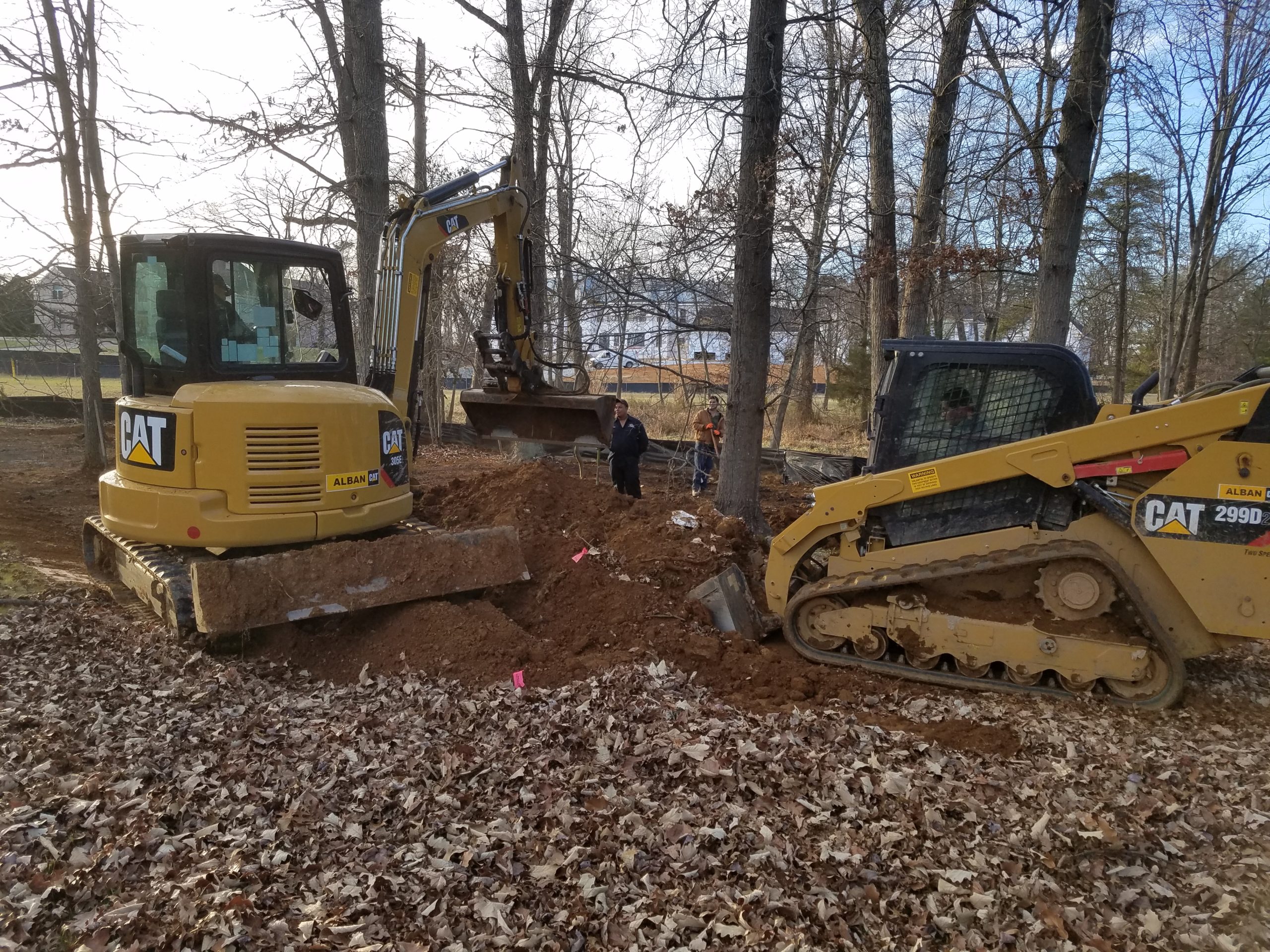When grading fill dirt, you are going to need some earth moving equipment.
Skid Loader
The skid loader is a rigid frame, engine powered machine with lift arms that are used to attach a wide variety of labor saving tools or attachments. Skid loaders are normally four wheel drive. The left side drive wheels that are independent of right side drive wheels. With each side being independent to the other, the wheel speed and direction of rotation of the wheels will determine which direction the loader turns.
Skid loaders are capable of turning in their own tracks. This makes them very maneuverable and valuable for jobs in reduce areas. With an agile loader for loading and grading topsoil and fill dirt, these compact loaders are invaluable.
Unlike conventional front loaders, the lift arms lay beside the driver. The major pivot points are located behind the shoulders of the operator. Due to the operator being in close proximity to moving booms and buckets, earlier models of skid loaders weren’t as safe as conventional front loaders, particularly during entering and exiting.
Skid loaders today have fully enclosed cabs and other safety features. These features protect the operator from injury. Just like other front loaders, the skid steer can scrape material from one location and carry dirt in a bucket, or load material on a truck or a trailer.
Operation
A skid loader can sometimes take the place of a large excavator. By digging a hole out from the inside. The skid loader will first dig a ramp that leads to the edge of the hole. Then, the loader will use the ramp to carry material out of the hole.
The skid loader will then reshape the ramp by making it steeper and longer as the excavation gets deeper. This method is very useful for digging dirt under an overhead structure where the overhead clearance doesn’t allow for the boom of a large excavator, such as those situations where you are digging a basement under a house.
The bucket of most types of skid loaders can be replaced with several specialized buckets or attachments, many of which are powered by the hydraulic system of the loader.
History
The first 3 wheeled front end loader was invented by two brothers, Cyril and Louis Keller in their machinist shop in Minnesota back in 1957. The Kellers built the loader to help a nearby farmer clean turkey manure from his two story barn. The light and compact loader, with the rear caster wheel, was able to turn around within the length of itself, while performing the very same tasks as conventional front end loaders.
Early Years
Down the road, the Melroe manufacturing company in Gwinner ND, purchased the rights to the Keller loader in 1958 and hired the brothers to continue their loader invention. Resulting from the
partnership, the M-200 self propelled loader was introduced at the end of 1958.
Initial Loader Features
The loader featured two independent front drive wheels and a rear caster wheel, a 12.9 engine and a 750 lb lift capacity. Two years later, they ended up replacing the caster wheel with a rear
axle and introduced the M-400 loader, which was the first four wheel skid steer loader in the world.
Bobcat Name
In 1962, the Bobcat name was added to describe the key features of the machine – touch, agile, and quick. The M-440 was powered by a 15.5 HP engine and offered a 1100 lb rated operating capacity. In the mid 1960s, the skid steer loader progressed with the introduction of the M600 loader.
Equipment Upgrades
Years later, the Bobcat skid steer loader experienced quite a few changes, including the development of a hydrostatic drive system, enforced cab structures, radius and vertical lift arm configurations, deluxe instrumentation, and even heating and air conditioning.
Today’s Compact Loaders
In addition to the rubber tire skid loaders of today, there are now all-wheel steer loaders and even compact track loaders. Compact track loads offer less ground disturbance and feature better traction and control in soft, muddy, wet, and even sandy ground conditions.
Earth Moving Equipment
There are many different opinions as to what machines should actually be classified as earth moving equipment. There are many different types of equipment that fall in this category, such as
excavators, backhoe loaders, dump trucks, and even loaders.
Other Equipment
Other machinery that falls in between are articulated trucks, wheel and track tractors, and even scrapers. The thin line is normally drawn at motor grades, which are more than capable or light
duty excavation, although they are mainly used to level lots, roads, including fill dirt grading and site work.
Improved Performance & Productivity
If you take a glance at any equipment literature from leading companies such as CAT, Komatsu, or Case, you’ll see right away that they believe the biggest and most important change over the last several years is increased productivity. This is normally followed by greater comfort and safety.
The increase in productivity is the result of many different advancements. CAT (Caterpillar) cites that more powerful engines with a faster rise in torque which allows machines to respond
faster to increased power demands. Even though this new generation is far more powerful, it has a reduced impact on the environment as well.
Electronics
Most of the newer machines have electronic control systems that will optimize both engine and transmission performance, as well as fuel consumption and hydraulic system performance.
Take for example the CAT mid sized G series wheel loaders that feature electronically controlled powershift transmissions. Each and every transmission offers autoshift capabilities that ease the pressure on the operator, and an electronic clutch pressure control that smooth shifts the gears for longer life.
Comfort
 In the industry, good operators are getting harder and harder to find. Manufacturers find themselves stressing that operator comfort and convenience need to be taken into account not only to make the job easier, but also more efficient and productive as well for digging and grading fill dirt and all materials.
In the industry, good operators are getting harder and harder to find. Manufacturers find themselves stressing that operator comfort and convenience need to be taken into account not only to make the job easier, but also more efficient and productive as well for digging and grading fill dirt and all materials.
The new cab designs offer better visibility, reduced noise and vibration, and improved comfort as well. The new control systems will require low operator effort while also improving the control of the machine for both the experienced as well as the in-experienced operator.
Easier maintenance
Almost all new machinery offers electronic monitoring systems that will provide constant information on the health of the machine for the operator. These types of systems provide information to technicians, including service modes that will help them to diagnose conditions quickly.
Now days, machines are designed to make routine maintenance easier. With CAT’s wheel loaders, regular service points are easy to access from ground level, with site gauges making it easier
to check the fluid of the radiator, hydraulic oil, and transmission – without having to use dipsticks.
The Importance of Modern Skid Loaders in Grading Fill Dirt
When grading fill dirt, modern skid loaders play an essential role in ensuring precision and efficiency. These machines offer unmatched maneuverability, allowing operators to navigate tight spaces with ease. The advanced electronic control systems in today’s skid loaders not only enhance productivity but also improve safety and comfort, making them ideal for both experienced and novice operators. Whether you’re working with compact track loaders for soft ground conditions or all-wheel steer loaders for varied terrains, these versatile machines are indispensable for effective fill dirt grading.
Changes for the Better
The excavation equipment of today you will notice the changes are better. The machines of the past relied more on operator skill and technique, as very few of them had electronic features. These advances make grading fill dirt a breeze.
Today, almost all types of heavy machinery offer electronic features. Electronics are a great thing, as they can make the life of an operator easier than ever. You don’t need to get out and check the fluids anymore. All you need to do is take a look at your instrument panel, which can help to save you a lot of time.
The machines of the past can’t compete with machines of today. With technology always getting better, what is in the future for heavy machinery? Years from now, one can only begin to wonder just great heavy machinery will get. What other features will make the life of an operator even easier than it is now.
Summary

Dirt Connections was started with one goal in mind: providing quality residential and commercial construction services to clients on time and on budget. Reach out for more information on how we can support your next project.
For your convenience our estimates are free and by appointment. Call 703-940-9949 for a free estimate today!













































